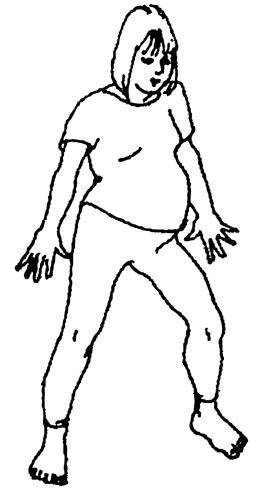World Respecting Childbirth Week (WRCW)
Positions in childbirth : actors, directors, free choice…
WRCW — 23–29 May, 2005
Objectives
- to promote the awareness that the culture of obstetrical risk and active management of labour (exclusively justified by the constraints of staff management) led to the loss of self-confidence of a whole generation of women with respect to giving birth. A growing number of professional birth attendants (doctors and midwives) are now trying to step out of this “productivist” model. However, only well-informed users have the potential to foster a radical change of medical practice with the support of law-makers.
- to encourage the free choice of labour positions with the effect of:
- minimizing pain, and further the use of (epidural) analgesia;
- reducing the average length of labour without stimulating it with artificial hormones;
- (according to a few studies) to reduce the risk of post-partum hemorraghe, the main cause of maternal deaths;
- better protecting the perineum during the ejection phase.
- to share scientific evidence via the AFAR database…
How to proceed practically
- broadcast information on the media;
- give access to information to pregnant women (social welfare office, gatherings of mothers…) and teenagers;
- suggest actions for individual, informal groups, non-profit societies, professional agencies and media in various countries;
- arrange meetings, conferences, interviews with the local press or radio;
- supply more links and documents on this topic for the web pages and database;
- comment on existing resources;
- organize all sorts of satellite events;
- translate the available material to more languages, etc.

Resources
- NCT (National Childbirth Trust) posters. These posters are displayed in hospitals in the UK. A French version is currently distributed by AFAR. [correction liens/2012 => page posters du site AFAR]
- Recto (low definition in English) -> buy paper posters on line
- Verso (low definition in English) -> buy paper posters on line
- Recto (low definition in French)
- Verso (low definition in French)
- Recto (high definition A4 in French)
- Verso (high definition A4 in French)
- Recto (high definition A3 in French)
- Verso (high definition A3 in French)
- Informed Choice leaflets (MIDIRS http://www.midirs.org/)
- Upright positions useful for labour and birth (Empowered Childbirth)
- Birthing positions in Sweden (Folkhälsoinstitutet)
- Pushing Positions (Connie Banack)
- Physiological Second-Stage Labor (Midwifery Today E‑News)
- Pushing for First-Time Moms (Gloria Lemay) [also in Spanish and French]
- Birth positions (Ronnie Falcao)
- Position and Movement during the First Stage of Labour (World Health Organization)
Several studies show that, during the first stage of labour, the supine position affects the blood flow in the uterus. The heavy uterus can cause aortocaval compression and the reduced blood flow can compromise the condition of the fetus. The supine position is also found to reduce the intensity of the contractions (Flynn et al 1978, McManus and Calder 1978, Williams et al 1980, Chen et al 1987), and thus interferes with the progress of labour. Standing and lying on the side are associated with greater intensity and greater efficiency of the contractions (their ability to accomplish cervical dilatation).
Despite the continued prevalence of the supine position many options are open to women in labour. However, various constraints frequently limit those options, from the design of the delivery-suite bed to delivery protocols or the presence of routine intravenous lines or monitoring equipment. Where such constraints are kept to a minimum women can stand, walk, sit upright or on hands and knees, take a shower or a bath to relax or adopt each position alternately as they choose. Trials that have compared these positions to the supine have found that, on average, labour was experienced as less painful (there was less need for analgesia) and augmentation was used less frequently in the non-supine positions (Chan 1963, Flynn et al 1978, McManus and Calder 1978, Diaz et al 1980, Williams et al 1980, Hemminki 1983, Melzack 1991). One trial (Flynn et al 1978) found a significantly lower incidence of fetal heart rate abnormalities in the upright position, but other trials detected no significant differences in neonatal outcomes.
In conclusion, there is no evidence to support the encouragement of the supine position during the first stage of labour. The only exception is where the membranes have ruptured in the presence of a non-engaged fetal head. If and when the membranes are ruptured and the birth attendant has established a sufficient engagement of the fetal head, women should be free and encouraged to choose the position they prefer during labour. They will often change positions, as no position is comfortable for a long period of time.
(Reference: Care in normal birth: A practical guide) - Maternal Position during the Second Stage (World Health Organization)
[…] for both the first and the second stage, […] women can adopt any position they like, while preferably avoiding long periods lying supine. They should be encouraged to experiment with what feels most comfortable and should be supported in their choice. Birth attendants need training in coaching and performing births in other positions than the supine in order to not be an inhibiting factor in the choice of position.
(Reference: Care in normal birth: A practical guide) - Aprenda a nascer e a viver com os índios: Parto de cócoras, desempenho sexual e ginástica indígena (a book by Moysés Paciornik, in Portuguese)
- Ideas alrededor de las posiciones para parir y la sexualidad (in Spanish)
A point on actions in various countries…
(We will report all actions after WCRW, in June 2005)
- Argentine
- France
- Latin America
- Québec (Canada)
- Switzerland
- The Netherlands
- United Kingdom
- USA


